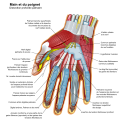Датотека:Wrist and hand deeper palmar dissection-numbers.svg

Величина PNG прегледа за ову SVG датотеку је 474 × 600 пиксела. 6 других резолуција: 190 × 240 пиксела | 379 × 480 пиксела | 607 × 768 пиксела | 809 × 1.024 пиксела | 1.619 × 2.048 пиксела | 555 × 702 пиксела.
Оригинална датотека (SVG датотека, номинално 555 × 702 пиксела, величина: 207 kB)
Историја датотеке
Кликните на датум/време да бисте видели тадашњу верзију датотеке.
| Датум/време | Минијатура | Димензије | Корисник | Коментар | |
|---|---|---|---|---|---|
| тренутна | 19:15, 1. јун 2015. |  | 555 × 702 (207 kB) | Perhelion | optimize image |
| 13:42, 8. јул 2012. |  | 555 × 702 (399 kB) | Wilfredor | optimize image | |
| 23:11, 13. јануар 2009. |  | 555 × 702 (817 kB) | Wilfredor | {{Information |Description= |Source= |Date= |Author= |Permission= |other_versions= }} | |
| 18:37, 16. октобар 2008. |  | 555 × 702 (815 kB) | Wilfredor | {{Information |Description= |Source= |Date= |Author= |Permission= |other_versions= }} | |
| 21:33, 23. јул 2008. |  | 770 × 767 (822 kB) | Bibi Saint-Pol | {{Created with Inkscape}} == {{int:filedesc}} == {{Information |Description= {{en|The hands (med./lat.: manus, pl. manūs) are the two intricate, prehensile, multi-fingered body parts normally located at the end of each arm of a human or other primate. Th |
Употреба датотеке
Следећа страница користи ову датотеку:
Глобална употреба датотеке
Други викији који користе ову датотеку:
- Употреба на af.wikipedia.org
- Употреба на ar.wikipedia.org
- Употреба на az.wikipedia.org
- Употреба на bjn.wikipedia.org
- Употреба на bn.wikipedia.org
- Употреба на br.wikipedia.org
- Употреба на ce.wikipedia.org
- Употреба на crh.wikipedia.org
- Употреба на cv.wikipedia.org
- Употреба на da.wikipedia.org
- Употреба на de.wikipedia.org
- Употреба на en.wikipedia.org
- Wikipedia:Featured picture candidates/Wrist and hand deeper palmar dissection-en.svg
- Wikipedia:Featured picture candidates/April-2009
- User:Madhero88/Medicalg
- Wikipedia:WikiProject Anatomy/Resources
- Wikipedia talk:WikiProject Anatomy/Archive 9
- User talk:Rhododendrites/Reconsidering FPC on the English Wikipedia
- Употреба на es.wikipedia.org
- Употреба на fa.wikipedia.org
- Употреба на fr.wikipedia.org
- Употреба на hr.wikipedia.org
- Употреба на hu.wikipedia.org
- Употреба на id.wikipedia.org
- Употреба на incubator.wikimedia.org
- Употреба на iu.wikipedia.org
- Употреба на ko.wikipedia.org
- Употреба на lbe.wikipedia.org
- Употреба на lb.wikipedia.org
- Употреба на lt.wikipedia.org
- Употреба на ms.wikipedia.org
- Употреба на nia.wiktionary.org
- Употреба на os.wikipedia.org
- Употреба на pl.wikipedia.org
- Употреба на pt.wikipedia.org
- Употреба на ru.wikipedia.org
Још глобалног коришћења ове датотеке.







